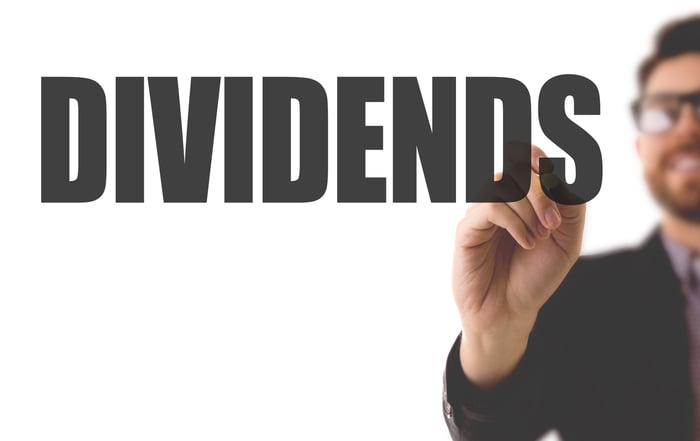Enbridge (ENB -0.07%) operates in the energy patch, which might leave some investors worried about volatile cash flows. These worries are not unfounded, given the impact that rising and falling oil and natural gas prices can have on drillers. However, Enbridge is a midstream company -- and that changes the equation in a big way, making it a highly reliable dividend stock. Here are some charts to show why you might want to jump aboard.
1. Stuck in the middle
Midstream companies like Enbridge help to move oil and natural gas from where they are produced to where they get used. They own things like pipelines, storage, transportation, and processing assets. Demand for this vital infrastructure tends to remain fairly constant no matter the price at which oil and natural gas trade. Enbridge and other midstream companies generally charge fees for the use of their assets, sort of like charging a toll for the use of a bridge.

Image source: Getty Images.
As the chart below shows, Enbridge's dividend has headed steadily higher despite the extreme swings in oil prices. That said, it is important to note that Enbridge is a Canadian company, so the dividend U.S. investors receive will rise and fall along with exchange rates. In Canadian dollars, Enbridge has increased its dividend every year for 28 consecutive years.
ENB Dividend Per Share (Annual) data by YCharts.
In other words, Enbridge is a reliable dividend stock despite the fact that it operates in the highly volatile energy sector.
2. Comfortable with the leverage
Building a portfolio of vital energy-infrastructure assets requires a lot of money, which generally leads to leverage. Enbridge has more leverage than some of its closest peers, as the chart below shows. But that's not an unsustainable situation. The company has worked with, and is comfortable with, the amount of leverage it has today.
ENB Financial Debt to EBITDA (TTM) data by YCharts.
Notably, the management highlighted during its first-quarter 2023 earnings conference call that it "exited the quarter at 4.6 times debt-to-EBITDA near the bottom of our range." In other words, there's probably not much to worry about here on the debt front. Moreover, the company's balance sheet has earned an investment-grade credit rating. So it does, indeed, appear to be on solid financial ground despite having more leverage than many of its peers.
3. Reliable growth
The next graphic is from Enbridge's Q1 2023 earnings presentation. It shows a breakdown of the company's long-term expectations for earnings before interest, taxes, depreciation, and amortization (EBITDA) growth.

Image source: Enbridge.
In essence, management thinks that the combination of built-in fee increases, development, and acquisitions and stock repurchases will allow it to achieve 5% EBITDA growth, on average, over the foreseeable future. That said, over the next couple of years distributable cash-flow growth is projected to be a bit weaker at around 3%, which will likely mean a couple of years of modest dividend growth. However, longer-term distributable cash-flow growth is expected to move up toward the mid-single digits.
ENB Dividend Yield data by YCharts.
This isn't a dividend-growth story, really; it's more about a reliable dividend that should keep up with inflation over time. The historically high 7.1% dividend you can collect if you buy the stock today will likely represent the lion's share of your return over time. But as long as you go in knowing that fact and are looking to maximize the income your portfolio generates, that shouldn't be too much of a problem.
Not perfect but quite attractive
The performance of all companies waxes and wanes over time. Enbridge's business is facing a near-term slow down, and exchange rates haven't been favorable, leading investors to shift away from the stock. Rising interest rates, which make other income options (like CDs) more attractive, haven't helped either.
But if you are a long-term dividend investor, the company's proven history of investing for growth, leading to regular dividend increases, should be very attractive. The high yield just means you'll get paid well while you wait for better days.








